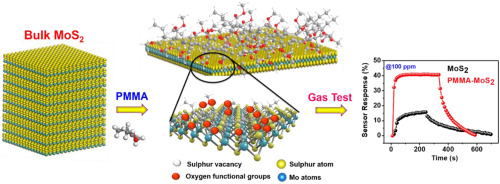当前位置:
X-MOL 学术
›
J. Alloys Compd.
›
论文详情
Our official English website, www.x-mol.net, welcomes your feedback! (Note: you will need to create a separate account there.)
Effect of PMMA on the surface of exfoliated MoS2 nanosheets and their highly enhanced ammonia gas sensing properties at room temperature
Journal of Alloys and Compounds ( IF 6.2 ) Pub Date : 2020-08-01 , DOI: 10.1016/j.jallcom.2020.155005 Abebaw Abun , Bohr-Ran Huang , Adhimoorthy Saravanan , Deepa Kathiravan , Po-Da Hong
Journal of Alloys and Compounds ( IF 6.2 ) Pub Date : 2020-08-01 , DOI: 10.1016/j.jallcom.2020.155005 Abebaw Abun , Bohr-Ran Huang , Adhimoorthy Saravanan , Deepa Kathiravan , Po-Da Hong

|
Abstract Highly sensitive ammonia (NH3) gas sensors were fabricated through polymethyl-methacrylate (PMMA) assisted exfoliation of molybdenum disulfide (MoS2) based multilayered nanosheets. The PMMA-MoS2 nanocomposites were successfully prepared by facile ultra-sonication technique. The physical-chemical properties of PMMA assisted MoS2 nanocomposites were evaluated by various analytical methods. High resolution Transmission Electron Microscopy and AFM results were revealed the uniform and thin surface coating of PMMA on the MoS2 sheets. Most importantly, obtained PMMA-MoS2 nanocomposites were dropped on SiO2/Si substrates, subsequently fabricated lateral integrated Pt electrodes to measure the gas sensing properties. Remarkable sensing properties obtained for PMMA-MoS2 nanocomposite-based sensor with an excellent sensitivity of (54%), which is significantly higher than that of bulk MoS2 (15.2%). Moreover, the fabricated PMMA-MoS2 nanocomposites based gas sensor possesses excellent selectivity to H2, C3H6O, and CO2. The observed results exhibit that the exfoliation of MoS2 with PMMA using ultra sonication techniques are promising for enhanced NH3 gas monitoring. Compared to the pure MoS2, the adsorption ability of PMMA-MoS2 surface induces the oxygen functional groups strongly affect the sensing properties. The superior gas sensing properties of this present surface modified PMMA-MoS2 hybrid sensors are promising and sustainable compared with the existing MoS2 based NH3 sensors.
中文翻译:

PMMA对剥离的MoS2纳米片表面的影响及其在室温下高度增强的氨气传感性能
摘要 通过聚甲基丙烯酸甲酯 (PMMA) 辅助剥离基于二硫化钼 (MoS2) 的多层纳米片制造高灵敏度氨 (NH3) 气体传感器。PMMA-MoS2 纳米复合材料是通过简便的超声波技术成功制备的。PMMA 辅助的 MoS2 纳米复合材料的物理化学性质通过各种分析方法进行评估。高分辨率透射电子显微镜和 AFM 结果显示在二硫化钼片上均匀且薄的 PMMA 表面涂层。最重要的是,将获得的 PMMA-MoS2 纳米复合材料滴在 SiO2/Si 衬底上,随后制造横向集成 Pt 电极以测量气敏特性。基于 PMMA-MoS2 纳米复合材料的传感器获得了显着的传感特性,具有 (54%) 的出色灵敏度,这明显高于块状 MoS2 (15.2%)。此外,所制造的基于 PMMA-MoS2 纳米复合材料的气体传感器对 H2、C3H6O 和 CO2 具有出色的选择性。观察到的结果表明,使用超声波技术用 PMMA 剥离 MoS2 有望用于增强 NH3 气体监测。与纯 MoS2 相比,PMMA-MoS2 表面的吸附能力诱导氧官能团强烈影响传感性能。与现有的基于 MoS2 的 NH3 传感器相比,这种现有表面改性 PMMA-MoS2 混合传感器的优越气体传感特性是有前途和可持续的。观察到的结果表明,使用超声波技术用 PMMA 剥离 MoS2 有望用于增强 NH3 气体监测。与纯 MoS2 相比,PMMA-MoS2 表面的吸附能力诱导氧官能团强烈影响传感性能。与现有的基于 MoS2 的 NH3 传感器相比,这种现有表面改性 PMMA-MoS2 混合传感器的优越气体传感特性是有前途和可持续的。观察到的结果表明,使用超声波技术用 PMMA 剥离 MoS2 有望用于增强 NH3 气体监测。与纯 MoS2 相比,PMMA-MoS2 表面的吸附能力诱导氧官能团强烈影响传感性能。与现有的基于 MoS2 的 NH3 传感器相比,这种现有表面改性 PMMA-MoS2 混合传感器的优越气体传感特性是有前途和可持续的。
更新日期:2020-08-01
中文翻译:

PMMA对剥离的MoS2纳米片表面的影响及其在室温下高度增强的氨气传感性能
摘要 通过聚甲基丙烯酸甲酯 (PMMA) 辅助剥离基于二硫化钼 (MoS2) 的多层纳米片制造高灵敏度氨 (NH3) 气体传感器。PMMA-MoS2 纳米复合材料是通过简便的超声波技术成功制备的。PMMA 辅助的 MoS2 纳米复合材料的物理化学性质通过各种分析方法进行评估。高分辨率透射电子显微镜和 AFM 结果显示在二硫化钼片上均匀且薄的 PMMA 表面涂层。最重要的是,将获得的 PMMA-MoS2 纳米复合材料滴在 SiO2/Si 衬底上,随后制造横向集成 Pt 电极以测量气敏特性。基于 PMMA-MoS2 纳米复合材料的传感器获得了显着的传感特性,具有 (54%) 的出色灵敏度,这明显高于块状 MoS2 (15.2%)。此外,所制造的基于 PMMA-MoS2 纳米复合材料的气体传感器对 H2、C3H6O 和 CO2 具有出色的选择性。观察到的结果表明,使用超声波技术用 PMMA 剥离 MoS2 有望用于增强 NH3 气体监测。与纯 MoS2 相比,PMMA-MoS2 表面的吸附能力诱导氧官能团强烈影响传感性能。与现有的基于 MoS2 的 NH3 传感器相比,这种现有表面改性 PMMA-MoS2 混合传感器的优越气体传感特性是有前途和可持续的。观察到的结果表明,使用超声波技术用 PMMA 剥离 MoS2 有望用于增强 NH3 气体监测。与纯 MoS2 相比,PMMA-MoS2 表面的吸附能力诱导氧官能团强烈影响传感性能。与现有的基于 MoS2 的 NH3 传感器相比,这种现有表面改性 PMMA-MoS2 混合传感器的优越气体传感特性是有前途和可持续的。观察到的结果表明,使用超声波技术用 PMMA 剥离 MoS2 有望用于增强 NH3 气体监测。与纯 MoS2 相比,PMMA-MoS2 表面的吸附能力诱导氧官能团强烈影响传感性能。与现有的基于 MoS2 的 NH3 传感器相比,这种现有表面改性 PMMA-MoS2 混合传感器的优越气体传感特性是有前途和可持续的。


























 京公网安备 11010802027423号
京公网安备 11010802027423号